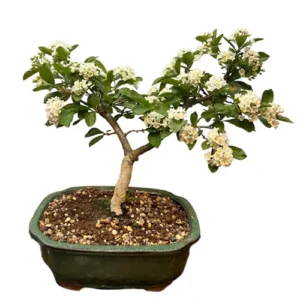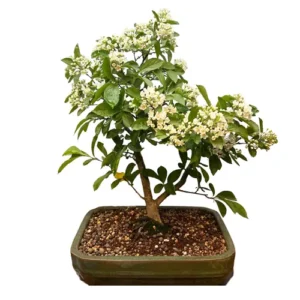Ilex serrata
Japanese Winterberry Bonsai
Native to Japan and China. This half-hardy holly is known and grown for its glossy red berries. A deciduous species, they bear different foliage according to their sexes. For fruit to arrive both are needed for successful pollination.
Japanese Winterberry Bonsai Care Tips
Placement
Choose an outdoor spot that can provide full sun across the summer and the autumn. Male and Female trees need to be placed alongside one another for effective flowering. Consider some protection from the hottest summer sun. The fruit these bonsai bear is rather appealing for birds, consider a birdcage or adequate protection from them stealing the fruit in autumn and winter. In a temperate climate like the UK, Japanese Winterberry will require frost protection from a shed or greenhouse in the winter and spring.
Watering
Be sure to water this plant consistently throughout the growing season. Water as soon as the surface of the soil feels dry. The soil should be kept just moist in winter. Do not let the rootball dry, even temporarily this can kill the plant.
Feeding & Fertilising
Across the growing season, a balanced liquid feed can be used weekly. Solid feed also works. Toward the end of summer, Japanese Winterberry bonsai appreciate a feed low in nitrogen content.
Pruning & Wiring
Pruning your bonsai is important not only to create or maintain an aesthetic style but to also ensure optimal health. After four leaves have grown cut back new shoots to two leaves. Avoid defoliating entirely as this specimen relies on leaves for producing fruit.
Wire your Japanese Winterberry from autumn to spring. We recommend using wires with a thickness that matches the thickness of the branch: if the wire you choose is too thick you will damage the bark. If it is too thin, it won’t be effective.
Repotting
Repotting your tree is an important way to provide a fresh and suitable soil mix and ensure appropriate root health. Repot Japanese Winterberry Bonsai at the start of spring every two to three years.
Trees that are ready for repotting will require root pruning, a suitable new pot and appropriate soil mix.
When repotting, do not cut back the root mass by a large amount, and choose a well-draining soil mix that has a neutral or slightly higher PH value of 5-6 but not over 7. We tend to use a mixture of different speciality bonsai soils on our trees. Every species is different so please contact us for free soil-mix advice or to take advantage of our repotting service.
Bonsai trees aren’t only magnificent additions to an indoor oasis, they are more than capable of standing out in any garden. Many Bonsai species are incredibly hardy and withstand nature’s colder and damper turns with aplomb making them worthwhile outdoor plants. We have an extensive library of care guides for outdoor bonsai trees. It’s not about selecting the perfect bonsai, it’s about selecting the perfect bonsai for you.
The Ilex genus is a species of trees, shrubs and climbing plants that totals over 500. Typically these are hardy plants with glossy and tough leaves making them far from easy to style. Further Ilex species that are commonly used for bonsai include the Japanese Holly and the Common Holly. These deciduous and evergreens make for challenging and rare bonsai specimens but are popular with hobbyists worldwide.
Japanese Winterberry Bonsai - Typical Queries
Do Japanese Winterberry bonsai get pests and diseases?
This bonsai is generally a trouble-free species. Its only potential intruders are Ahpids. Young shoots in particular can attract spring aphids. This should be cared for with the appropriate insecticide.
How to propagate Japanese Winterberry bonsai?
Japanese Winterberry can be propagated with both seeds and cuttings. It’s best to take semi-ripe cuttings at the end of Summer or the start of Autumn. Seeds should be sown outside in Autumn. They can take over two years to show growth.
Is Japanese Winterberry a good bonsai for beginners?
This is a challenging bonsai to care for. If seeking fruits, it will require two trees of the opposing sex to make this possible. The placement of this bonsai isn’t so simple to care for, season for season, and its fruits tend to attract birds. This may be a lot for a beginner to keep up with.





















